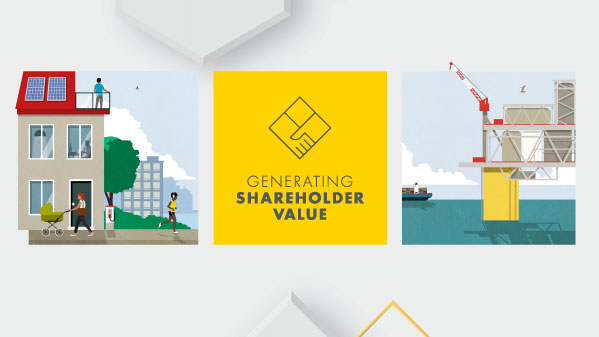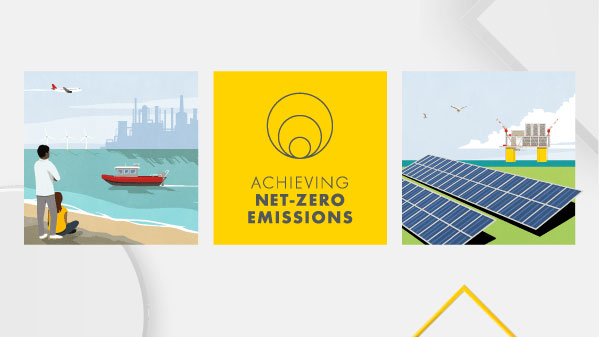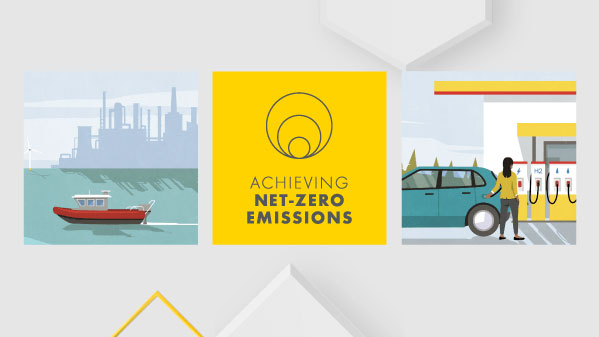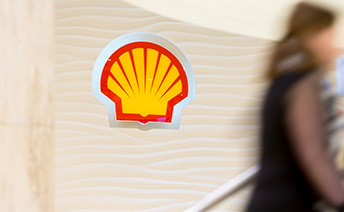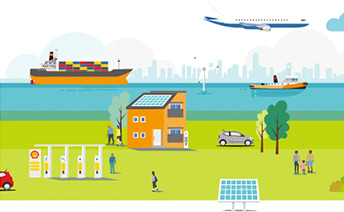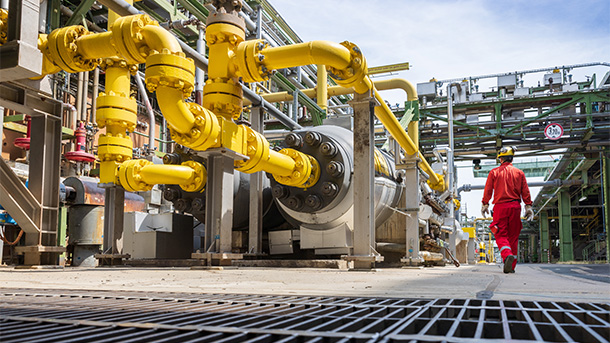Performance indicators
These indicators enable management to evaluate Shell’s performance against our strategy and operating plans during the year. They are also used as part of the determination of Executive Directors’ remuneration. See “Directors’ Remuneration Report”.
Financial delivery
Click the box for more information.
Cash flow from operating activities ($ billion)
Cash flow from operating activities is the total of all the cash receipts and payments associated with our sales of oil, gas, chemicals and other products. The components that provide a reconciliation from income for the period are listed in the “Consolidated Statement of Cash Flows”. This indicator reflects our ability to generate cash to service and reduce our debt and for distributions to shareholders and for investments.
See “Financial framework”.
Progress in the energy transition
Click the box for more information.
Selling lower-carbon products (%)
The percentage of Marketing segment Adjusted Earnings from low-carbon energy products (on a life cycle basis), defined as biofuels and EV charging, as well as non-energy products, defined as lubricants, bitumen, sulphur, and earnings from convenience retail.
See “Our journey to net zero”.
Reducing operational emissions (thousand tonnes CO2)
GHG abatement projects in 2022 that resulted in sustained GHG reductions (e.g. flare reduction projects or energy efficiency projects), site closures and decommissioning or transformations, and use of renewable electricity for Scope 2 reduction.
See “Our journey to net zero”.
Electric vehicle (EV) charge points (thousand)
All charge points in Mobility organisation which includes both public out-of-home and Shell Recharge Solutions.
See “Our journey to net zero”.
Operational excellence - Asset management excellence
Click the box for more information.
Upstream controllable availability (%)
Upstream controllable availability performance reflects our ability to optimally run our Upstream assets. Reliability issues, turnarounds and maintenance at own-operated or third-party facilities all impact controllable availability, but it excludes the impact of extreme unexpected events that are outside our control such as government restrictions and hurricanes. Upstream controllable availability includes all Shell-operated assets (excluding Groningen) and selected assets not operated by Shell, but for which Shell has strategic influence.
Midstream availability (%)
Midstream availability shows to what extent liquefied natural gas (LNG) assets are ready to process product as a comparison with capacity, considering the impact of planned and unplanned maintenance.
Refinery and chemical plant availability (%)
Refinery and chemical plant availability is the weighted average of the actual uptime of plants as a percentage of their maximum possible uptime. The weighting is based on the capital employed, adjusted for cash and non-current liabilities. This indicator is a measure of the operational excellence of our refinery and chemical plant facilities.
Operational excellence - Project delivery excellence
Click the box for more information.
Project delivery on schedule (%)
Project delivery reflects our capability to complete major projects on time and within budget on the basis of the targets set in our annual business plan. Project delivery on schedule measures the percentage of projects delivered on schedule.
Project delivery on budget (%)
Project delivery on budget reflects the aggregate cost against the aggregate budget for those projects, where a figure greater than 100% means over budget.
Operational excellence - Customer excellence
Click the box for more information.
Customer satisfaction (index)
The customer satisfaction index (CSI) score is generated from a transactional survey programme measuring performance (customer interactions). CSI is calculated as the average of customer satisfaction scores from email surveys.
Brand preference (%)
Brand Share Preference is the percentage of customers who answer ‘Shell’ in response to the question: “Assuming that all the fuel station companies that you would consider are conveniently located, which ONE company do you prefer most?”. Responses are taken from survey respondents in more than 60 countries covering both fuel and non-fuel retail B2C customers.
Safety
Click the box for more information.
Personal safety (SIF-F cases per 100 million working hours)
Serious Injury, Illness and Fatality (SIF) is defined as a serious work-related injury or illness that resulted in fatality or a life-altering event, which is defined as a long-term or permanent injury or illness with significant impact on daily activities. Serious Injury and Fatality Frequency (SIF-F) is calculated by dividing the number of employee and contractor SIF by 100 million working hours.
See “Safety”.
Process safety (number of events)
A Tier 1 process safety event is an unplanned or uncontrolled release of any material, including non-toxic and non-flammable materials, from a process with the greatest actual consequence resulting in harm to employees, contract staff, or a neighbouring community, damage to equipment, or exceeding a threshold quantity, as defined by the API Recommended Practice 754 and IOGP Standard 456. A Tier 2 process safety event is a release of lesser consequence.
See “Safety”.
- [A]2021 adjustment on Tier 1+2 count from 102 to 103 due to an event identified after publication.

